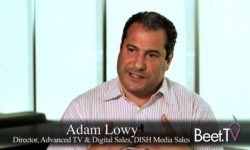It’s taking awhile, but the advertising space is “progressing and modernizing” to keep up with changing viewing behavior, with virtual MVPD’s representing the best of what TV can be, according to Adobe’s Todd Gordon.
“What we hear consistently from clients is that they still believe that TV is extremely effective in driving brand preference, driving store traffic, driving sales,” Gordon, who is Director of Programmatic TV, says in this interview with Beet. TV. “But it’s a much more complicated TV world to navigate” given the multiplicity of inventory sources, erosion of linear ratings and a diversity of suppliers.
Moreover, traditional linear TV needs more automation to establish a connection between audience targets and inventory, according to Gordon.
Referring to virtual MVPD’s as “truly the best of what is TV,” Gordon notes that it provides great access to content and the linear ad feed and can be supplemented with on-demand content. “All of which can be delivered, whether it’s on demand or in the linear feed, through IP pipes and the advertising can be delivered on a one to one basis instead of one to many.”
As a demand-side video ad platform from its acquisition of TubeMogul about two years ago, Adobe Advertising Cloud is using addressable opportunities that make the most sense given an advertiser’s objectives.
“One of the clearest is when you want to reach your target because of the effectiveness of a TV-like environment to influence, but your target is narrow so that traditional ways of buying TV are not efficient enough,” says Gordon. “If you buy a million adult eighteen to forty-nine impressions and only a few percent of them are your true customer, the traditional way of buying TV doesn’t match up to that.”
Addressable also offers incremental audience reach for traditional linear buys.
“Even with broad brand target, some of those consumers are going to be heavy viewers of TV and are going to be quite well reached in a traditional linear approach,” Gordon says. “Others may watch some TV but less than other people in the target.”
Using addressable to reach the hardest targets is a way of “evening out the frequency count among different groups and making sure that you’re extending the reach of that campaign to more qualified customers.”
A main focus of Adobe is providing more automation to linear TV to counter what Gordon describes as the “loss of fidelity” between a strategic target that’s developed in planning and a post-campaign buyer with a GRP goal.
“And so the view of the target that is created early in the process falls apart, really because the transaction is manual.”
There needs to be a more direction connection between linear inventory and tools used to optimize it, according to Gordon.
“So that instead of theoretically creating a target and then manually trying to find inventory that matches that target, you’re actually in platform decisioning against real, live inventory.”
Like others in the space, Adobe is seeing automotive as a category that’s widely embraced addressable owing to its advanced targeting and the high value of transactions. But packaged-goods are also coming on board “because in a lot of cases, a retailer sits in between the producer of the product and the transaction.
“It’s an area where data has been lacking, but there’s a lot of hunger in understanding that transaction better,” Gordon says.
This video is part of the Beet.TV series titled Targeting Today’s TV Viewer sponsored by DISH Media Sales. It is published along with this DISH Media Sales Straightforward Guide in ADWEEK. For more videos from the series, please visit this page.






































